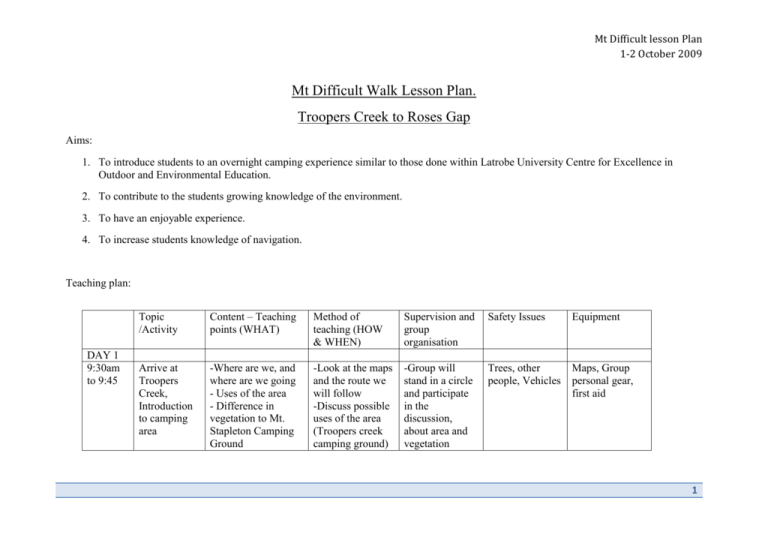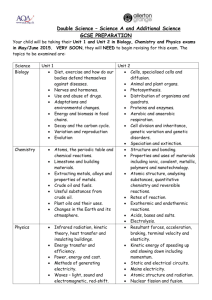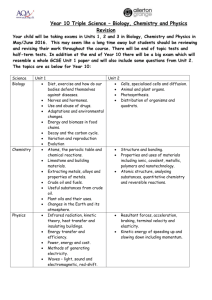Difficult lesson Plan - LTU
advertisement

Mt Difficult lesson Plan 1-2 October 2009 Mt Difficult Walk Lesson Plan. Troopers Creek to Roses Gap Aims: 1. To introduce students to an overnight camping experience similar to those done within Latrobe University Centre for Excellence in Outdoor and Environmental Education. 2. To contribute to the students growing knowledge of the environment. 3. To have an enjoyable experience. 4. To increase students knowledge of navigation. Teaching plan: DAY 1 9:30am to 9:45 Topic /Activity Content – Teaching points (WHAT) Method of teaching (HOW & WHEN) Supervision and group organisation Safety Issues Equipment Arrive at Troopers Creek, Introduction to camping area -Where are we, and where are we going - Uses of the area - Difference in vegetation to Mt. Stapleton Camping Ground -Look at the maps and the route we will follow -Discuss possible uses of the area (Troopers creek camping ground) -Group will stand in a circle and participate in the discussion, about area and vegetation Trees, other people, Vehicles Maps, Group personal gear, first aid 1 2 9:45 – 12:45pm Walk from Troopers creek camping ground to Mt. Difficult Camping area 12:451:15 Lunch -Walking safely, how to wear packs and about hotspots and blisters -Talk about and point out the differences in vegetation (sandy soils, native species) -Show students correct way to fit packs -Help students adjust packs where needed -Discuss what hot spots are and what to do if students get them - Either whole group or 2 split groups will look at the map and discuss the route (lead by the leader) - Discuss the formation of ‘Wind Swept Rock’ - Change in vegetation types (soil density, rock formation, flora/ orchids) - Talk about the formation of the rock, explore the rock - Discuss and provoke conversation about vegetation, as we ascend Mt. Difficult - Group will walk in a group, leaders will count group on a regular basis - When exploring rock, students will spot each other. Rocky terrain, steep outcrops, fallen trees, waterfall crossing (stream size), -leaders will Trees, rocky count group on a outcrops, knives Maps, Group personal gear, first aid, compass Food, Water, First aid kit, Mt Difficult lesson Plan 1-2 October 2009 regular basis -Set boundaries 1:15 – 1:45 Tree Game / Grokking 1:454:30 Walk from Mt. Difficult camp site to Briggs Bluff Camping area (294 056) Set up camp - Teach setting up of flys with inners - Talk about tree safety 4:30-5 5- 5:10 Toileting 5:106.00pm 6-7pm Naturalist activity (Bec) Dinner See Tree game/Grokking lesson plan -Re visit the use of landscape features for navigation. -Teach how to toilet hygienically and in an environmentally sound way (15cm) - Encourage - Group will students to use walk in a group, knowledge learnt leaders will on previous days count group on a to observe regular basis features -Demonstrate, -Set boundaries setting up of fly -Set safe with inner cooking area -Discuss tree -Check tent dangers (lean, sights dead limbs, sick trees, etc) - Discuss correct -Group will sit toileting in a circle. procedure, and the system we will use. See naturalist lesson plan knives Rocky ground, wind, Maps, Group personal gear, first aid, compass Trees, rocks, Personal gear, first aid, other group gear, Water. Trees, rocks, wind Trowel, toilet paper, hand sanitiser -leaders will Trees, rocky count group on a outcrops, regular basis knives, stoves, -set boundaries Food, Water, First aid kit, knives, cutlery, stoves, fuel, pots 3 4 7pm Free time Day 2 7:30 – 8:00am Breakfast 8-9 Pack up camp 9-10 Walk to the Briggs Bluff and back Expanding on environmental knowledge or navigation knowledge -Discuss about land use -Students will have this time to sketch, write, talk, etc. -We will encourage the students to think about and add to what they have learnt throughout the day - Group discussion on the bluff, leaders provoking conversation using questions -Set students boundaries -Leaders ensure that no student goes anywhere alone -Discuss an appropriate sleep time with group -Rocky outcrops, cliffs -Leaders will count group on a regular basis -Set boundaries -Leaders will count group on a regular basis -Set boundaries -Leaders walk dispersed throughout the group. -Leaders will count group on a regular basis -Set safe areas, Trees, rocky outcrops, knives Cliff, rocky outcrops, slippery rocks and woks, -Pencils and notepads Food, Water, First aid kit, Cutlery Personal gear, first aid, other group gear, Water. Water, first aid kit, sleeping bag, shelter, stove, map compass, whistle, phone, Mt Difficult lesson Plan 1-2 October 2009 10-12 Walk from campsite to Roses gap - talk about navigation -talk about vegetation, rock type - Open discussion of topics -Allow student to navigate this section of the walk -Ask students questions about the vegetation not too close to edge of cliff. -Leaders will be dispersed thought group -Group will walk in a group, -Leaders will count group on a regular basis Rocky outcrops, steep terrain, water fall crossing(stream size) Maps, Group personal gear, first aid, compass Aim Monitoring and Evaluation Aim 1 Monitoring Strategy Students participate in the overnight experience. Evaluation Strategy Observe participation of each individual on the trip. 5 Aim 2 Monitoring Strategy Observe student’s comments and questions in reference to the environment. Evaluation Strategy Pop quiz on the environment during the last section of the walk. Aim 3 Monitoring Strategy Observing students smiling and laughing during the activity Evaluation Strategy Listening to nightly conversations between peers Aim 4 Monitoring strategy Ask students questions about navigation in general Evaluation Strategy Observe students leading the navigation on the trip, and their use of the map and reliance on arrows. Safety and risk management: Completed with contribution of all group members. See the comprehensive safety plan. Listed below are some dangers specifically common to bushwalking, Risk Assessment and Management Matrix (Adapted from: Brown, 1999) Activity Type: Bushwalking Recognized Dangers 6 Risk Items (potential accident, Activity Location: Mt Difficult Risk Assessment (rate probability and Activity Date: 1-2/10/2009 Control Strategies (to reduce or eliminate Mt Difficult lesson Plan 1-2 October 2009 (hazard/peril) injury or other loss) magnitude as high, medium or low e.g.: Prob High Mag Low) risk) A. ENVIRONMENT (factors that impact on the activity) Rocks Students could fall off them causing injury. Students could hit their head on a rock, causing injury. Sun Sunburn Choose safe routes, without loose rocks . Where walking or scrambling over rocks have students spot each other and leaders assist students, when our route goes over rocks. Probability= high Ensure everyone wears sunscreen, long sleeved shirts and hats where possible. Remind students to reapply when we take regular breaks. Magnitude= med Dehydration /Heatstroke Cliffs Probability=low-med Magnitude=med Students could fall off a cliff causing serous injury. Probability=High/low Take breaks in shade and make sure students drink regularly. Magnitude= low/high Probability =low Magnitude=high Set safe areas at the top of cliffs. Do not allow students to wonder around cliff tops. 7 B. EQUIPMENT (resources that impact on the activity) Packs Ill fitting packs causing soreness or muscle injury. Probability= medium Magnitude= medium Fit packs to students at start of walk. Discuss ways to adjust them if they feel uncomfortable. Keep an eye on how students are going and ask them if they are uncomfortable. Whenever necessary stop to adjust packs. Shoes Blisters from ill fitting shoes Probability= high Talk to students and explain what hotspots are. encouraging students to stop and fix hotspots as soon as they occur, before they develop into blisters. Make sure students wear proper socks with their shoes. C. PEOPLE 8 Magnitude=low Mt Difficult lesson Plan 1-2 October 2009 Previous injuries Students with previous injuries, such as knee reconstructions, may have trouble with walk and could re-injure themselves Probability= medium Magnitude=medium Look at student’s medical forms that they are providing; be aware of any student s existing or past injuries. Make sure they know to let the leaders know if they are having any trouble. 9









